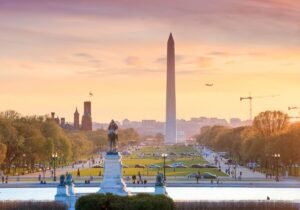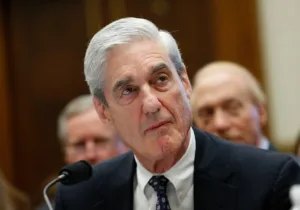Responding to the riots at the Capitol on January 6, the progressive online journal Vox raised the question, Are we entering a new era of political violence? Sean Illing, an editor at Vox, interviewed LSU political scientist and historian Nathan Kalmoe. The interview concludes with this:
Sean Illing: To your final point about the role of violence, are you saying that reciprocal violence may, regrettably, be necessary, presumably from the federal government?
Nathan Kalmoe: Law enforcement needs to do its job in protecting democratically elected leaders, the institutions of government, and the electorate more broadly. At times, that requires using force—even deadly force—to defend against violent attacks seeking to overturn the will of the people. Counter-violence by democracy’s supporters in the public is not necessary if law enforcement agencies do their jobs properly.
Americans are rightly skittish about supporting violence, even in response to violent authoritarian attacks. But US history shows that enforcing and advancing democracy has often required violence—usually by the federal government. Examples include the Revolution, the Civil War, Reconstruction, and federal action spurred by the civil rights movement.
Christian realists should, for the most part, concur with the view that at times force, up to and including lethal force, is required to defend against mob violence, although we may have quibbles over whether the justified and legitimate use of force, even lethal force, by lawful authority should also be termed “violence.” We also might wonder why, if the use of proportional and discriminant use of force is, indeed, justified and is a just response to riotous violence, we should be “skittish,” rather than be confident in ensuring justice, order, and peace. There is a significant cost for such skittishness, about which I will have more to say in a moment. Finally, we should not be so confident that “counter-violence” would not be necessary if law enforcement agencies do their jobs properly. What if they do their jobs properly and are overwhelmed by the mob? I’ll have something to say about that, as well.
Vox’s German Lopez, it is worth noting, also jumped on the law-and-order bandwagon recently, arguing that every person who forced their way into the Capitol should be arrested. Christian realists should happily embrace Lopez’s commitment to public order as well, but we might also want to ask the folks over at Vox about the timeliness of all this. Why are you embracing “reciprocal violence” and law and order now? Aren’t you a little late to the party? As Marc LiVecche reminded us in these pages, for months on end, we have witnessed a degradation of public order, with (quoting Charles Lipson), “mobs roaming city streets, unpunished; an effort to take over and firebomb a federal courthouse in Portland, unpunished; delegates attacked on the streets of Washington after the Republican convention, unpunished.” So, it is again worth noting that during the riots this past summer this same German Lopez, writing in Vox, declared that while “riots are destructive, dangerous, and scary,” they serve a purpose because they “can lead to serious social reforms.” The possibility of reciprocal violence did not seem to be on his menu of options back then.
Of course, it takes little imagination to see how aggrieved Trump-inspired rioters (or, to employ the absurd rhetoric of last summer, “mostly peaceful protesters”) might also embrace the idea that while riots are “destructive, dangerous, and scary,” they too might serve a purpose and lead to serious social reforms, as they conceive of it. One might be forgiven for thinking that for the progressive journalists at Vox, the support for reciprocal violence is less than principled, and rather selective, depending on whose political ox is being gored. Or, perhaps it is a simple matter of “a little bit of rioting for me, but not for thee.”
If the seeming hypocrisy from the folks at Vox were a one-off, just another predictable partisan bias of a “progressive” journal, it might be ignored as more of the same. But this sort of thing isn’t limited to progressive media outlets. As Commentary’s Christine Rosen, observed in the midst of the riots last summer,“excusing the violence as though it was an anomaly and not a consistent feature of these demonstrations became a media fixation. “Group Breaks Off of Mostly Peaceful Protest, Vandalizes Police Station, Sets Courthouse on Fire,” read one NBC News headline. “Third night of looting follows third night of mostly peaceful protest,” asserted another from the Wisconsin State Journal. To even call what municipal police routinely deemed riots “riots” was, in the estimation of CNN’s Chris Cillizza, an act of “desperation” by “embattled Republicans.” And, of course, who can possibly forget CNN’s great political philosopher, Chris Cuomo, brother of the New York governor and son of the former governor of New York, a certified card-carrying member of the political class, lecturing us on the virtues of violent protests: “Show me where it says that protesters have to be polite and peaceful,” he declared in prime time. For that, he has been justly mocked, in a video that has achieved minor cult status.
Nor was this embrace of the virtues of mob violence limited to the media and various and assorted pundits. As Noah Rothman—who, like Rosen, has been a severe critic of Donald Trump, especially his behavior in the weeks following his defeat in November—has observed, this tacit consent given to the rioters was also embraced by elected Democratic leaders. “And as city after city was engulfed by riots last summer, Democrats declined to condemn the excesses to which demonstrators appealed in the name of racial justice. Indeed, when the chaos in American streets was addressed at all, it was framed as a wholly righteous and unblemished demand for historical rectitude.”
Pointing all this out cannot be so cavalierly dismissed as mere “Whataboutism.” It is not “Whataboutism” to inquire into the principles(s) advanced to defend, prevaricate, or dismiss last year’s riots and then ask whether those same principles should apply to the riotous behavior in the Capitol as well, unless if pointing to such fecklessness is used to justify or excuse, or prevaricate about the violence and assault on the Capitol on January 6. Rather, exposing the fecklessness and irresponsibility of public officials and influential media voices during the riots last summer has the very real benefit of demonstrating how this way of thinking has something to do with the failure to protect our Capitol.
Such fecklessness and public incompetence were indeed evident throughout the summer, but that was because local public officials failed to learn from the first major incident following the death of George Floyd, namely, the assault and destruction of the 3rd Police Precinct in Minneapolis. State and local officials didn’t exactly cover themselves in glory:
As protests around the precinct became more violent, several City Council members urged the mayor and police chief to surrender the building, believing that the traditional police tactics — to hold the building at all costs — were further angering the public.
Minneapolis Mayor Jacob Frey and Police Chief Medaria Arradondo eventually decided that having officers stand their ground wasn’t worth the potential loss of life. If abandoning the station meant rewriting the tactical playbook for American policing, so be it, Frey said.
We are told, “It was such a departure from the norm that national policing experts say it will likely be studied for years to come.” Sure, in the same sense that the Battle of Kasserine Pass has been studied for years, as an archetypal example of military incompetence.
Incredibly enough, among the justifications for abandoning the precinct to the mob was the belief that while the Minneapolis police were focused on defending the 3rd Precinct Building (and themselves) from violent assault, the rest of the neighborhood was “largely unprotected against a few looters and arsonists among the protesters.”
You might think that the obvious response to a violent mob intent on killing police officers and razing their police station would be to call upon state and local law enforcement agencies and the National Guard to reinforce security. Rather than surrendering and abandoning a government building, a symbol of law and order, you would think they would be reinforced with sufficient strength to both secure the buildingand provide relief to the local police under siege, so that they can go about their normal law enforcement responsibilities. It is simply preposterous that, if augmented by Minnesota State Police, other local police forces, and the Minnesota National Guard, a perimeter around the precinct could not have secured the building and deterred an attack. You also might be suspicious of those who believe that an individual or group who would be so bold as to attack a police precinct would be satisfied with its destruction and then suddenly turn into law-abiding citizens. But last summer common sense was an uncommon virtue.
The order was given, instead, to abandon the precinct to the mob. And, predictably enough, the building was overrun and was subsequently burned to the ground. And what of those who advocated for sacrificing the precinct in the hope that it would cool tensions?
“It did nothing to quell anything,” Sgt. Sherral Schmidt, a leader of the police union, said of abandoning the station. [Mayor] Frey said that he can’t know if the outcome would have been different had he acted sooner or tried another strategy. “But, clearly, the murder of George Floyd has sparked a whole lot of anger and sadness,” he said. That night and the next, 75 fires were reported around the city. Damage has been estimated at half a billion dollars.
Here’s where we might question Professor Kalmoe’s claim that “counter-violence by democracy’s supporters in the public is not necessary if law enforcement agencies do their jobs properly.” Defending a police precinct and their persons from being attacked by a violent mob is, one would think, an example of a law enforcement agency “doing their jobs properly,” and yet they were overrun precisely because political authorities refused to consider the possibility of police and military reinforcement prepared to use (to employ Professor Kalmoe’s term) “reciprocal -violence.”
What does this all have to do with January 6? After all, the authorities did not, thankfully, entirely abandon the Capitol to the mob; they merely let the mob breach the building before eventually repelling them by applying “reciprocal violence” (if you wish) and killing one woman (unarmed, not that it matters) in the process. But, still, there are relevant similarities that are worth highlighting.
We are now learning from the Washington Post and other reports that the day before the attack on the Capitol, the FBI had issued a warning to local and national law enforcement authorities of a possible “war” at the Capitol. Earlier, the Associated Press had reported that despite information about pro-Trump protests in DC, “Capitol Police did not bolster staffing and made no preparations for the possibility that protests could escalate into violent riots, according to several people briefed on the law enforcement response. Officials turned down help offered by the Pentagon three days before the riot.”
While these initial media reports suggested that the fault rested entirely with the Capitol Police, more recently the US Capitol Police Chief Steven Sund, who resigned after the attack, told the Washington Post that security officials at the House and Senate rebuffed his early request to call in the National Guard ahead of the protest. Sund alleged that House Sergeant-at-Arms Paul Irving was concerned with the “optics” of declaring an emergency ahead of the protests and rejected a National Guard presence and that Senate Sergeant-at-Arms Michael Stenger recommended that he informally request the Guard to be ready in case it was needed to maintain security. Optics!
It has also been widely reported that Washington, DC, Mayor Muriel Bowser also insisted on a light police presence at the Capitol. At her insistence, the DC National Guard was relegated to serving as unarmed traffic cops in the DC Metro (the subway system). Meanwhile, some politicians, most notably Marcia Fudge, President-elect Joe Biden’s pick to serve as secretary of Housing and Urban Development, were quick to suggest that the failure of the Capitol Police to respond with sufficient force at the Capitol was evidence of racism, and that the Capitol Police were even “complicit” in this attack. The charge of racism is difficult to square with the fact that Bowser is a very progressive African-American politician.
Of course, it wasn’t “racism” that prompted Mayor Bowser (and other officials, as we shall see) from adequately responding to the threat, but rather, the failure to learn the obvious lesson that should have been learned from the assault on the 3rd Precinct in Minneapolis. The Associated Press offered up a more accurate assessment: “Still stinging from the uproar over the violent response by law enforcement to protests last June near the White House, officials also were intent on avoiding any appearance that the federal government was deploying active duty or National Guard troops against Americans.” Optics!
Bowser was not alone. Army Lt. Gen. Walter E. Piatt, director of the Army Staff, rejected a request for support from Sund, telling him that he couldn’t recommend that Army Secretary Ryan McCarthy authorize deployment. Piatt reportedly said, “I don’t like the visual of the National Guard standing a police line with the Capitol in the background.” Optics!
So, Senate and House security officials, the mayor of Washington, DC, and senior military officials, despite warnings of violence at the Capitol, were more concerned about the optics of mobilizing the requisite security forces to protect the Capitol than with ensuring the protection of the Capitol. Which, of course, is exactly what all this has in common with the feckless response to the assault on the 3rd Precinct.
Now, we must ask ourselves, what might a radical person or group with few qualms about engaging in politically motivated violence learn from it all? What would radicalized individuals and groups intent on doing violence at the Capitol have made of the response to the assault on the 3rd Precinct in late May 2020? Might they have arrived at the same conclusion as their ideological opposites intent on doing violence in later summer months in Seattle, Portland, New York, Kenosha, and Washington, DC—that “optics” and timidity in the face of a threat would trump public order and the protection of public officials and government property? One remarkably insightful and fair-minded left-wing reporter (a self-described supporter of Bernie Sanders) who has covered the BLM and Antifa riots and who also reported on the rioters as they assaulted the Capitol insists that, indeed, they had carefully studied, adopted, and implemented the insurrection tactics of Antifa and various anarchist groups (at 22:00 and 27:00 of the video).
It doesn’t really matter much if those intent on violence are inspired by Antifa or the half-baked postmodern neo-Marxist ideology of Black Lives Matter egged on by their fellow travelers in the media, or inspired by the crackpot conspiracy theories of QAnon egged on by their apologists on the dark web. Both sides are sufficiently rational to bank on the fecklessness, incompetence, and timidity of public officials and learn from the tactics of the other. Mob violence will beget mob violence. They will inevitably feed off each other. That’s why too much concern for the ideology of the rioters and their specific political grievances serves to blind too many to the problem to be confronted. Mob violence cannot be tolerated, and when threatened should be met with overwhelming force—as a deterrent, and with proportional and discriminant force, or “reciprocal violence” if you prefer—without apology, with far less concern for “optics,” and without any concern for the ideology of the mob if deterrence fails. If we can muster the courage, or perhaps simply the common sense to do just that, then the answer to the question, “Are we entering a new era of political violence?” will be, “Maybe, but not for long.” If we can’t, we will likely get more destruction and disorder, like that at the 3rd Precinct and the assault on the Capitol. And worse.






 Sponsor a student for Christianity & National Security 2024
Sponsor a student for Christianity & National Security 2024